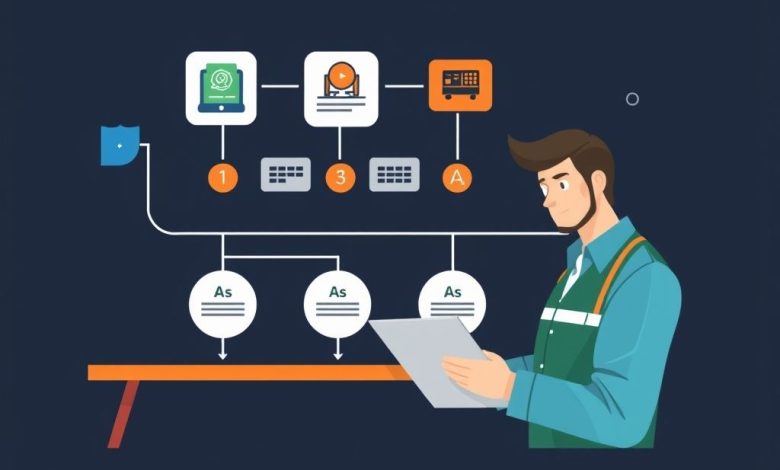Field Service Management with Onboarding Workflows

Field Service Management with Onboarding Workflows
Introduction
Field service management (FSM) refers to the processes and systems used to manage and coordinate work performed outside of a traditional office environment. This includes tasks such as scheduling appointments, dispatching technicians, managing inventory, and tracking customer interactions. In today’s fast-paced business landscape, effective FSM is crucial for maintaining high levels of customer satisfaction while maximizing operational efficiency.
One critical aspect of successful FSM implementation is the onboarding process for new employees, particularly technicians who will be interacting directly with customers. A well-designed onboarding workflow can significantly improve the transition period for new hires, ensuring they are equipped with the necessary knowledge and skills to perform their duties effectively from day one.
This article will explore the importance of field service management with onboarding workflows, highlighting key strategies and best practices for implementing these systems in your organization.
Key Components of Field Service Management
Field service management encompasses several critical components:
- Scheduling and Dispatching
- Efficient scheduling algorithms ensure optimal allocation of resources
- Real-time dispatch capabilities allow for quick response to customer needs
- Integration with GPS tracking enables accurate location-based routing
2. Work Order Management
- Centralized system for managing and assigning work orders
- Automated notifications for customers and technicians
- Customizable fields for capturing specific job details
3. Inventory Management
- Real-time tracking of parts and equipment
- Automatic alerts for low stock levels
- Integration with supplier networks for efficient restocking
4. Customer Relationship Management (CRM)
- Comprehensive database of customer information and history
- Automated follow-up reminders and surveys
- Analytics for identifying trends and improving service quality
5. Technician Productivity Tools
- Mobile apps for accessing schedules, work orders, and inventory
- Time tracking and reporting features
- Digital signature capabilities for service confirmations
6. Reporting and Analytics
- Customizable dashboards for real-time insights
- Performance metrics for technicians and teams
- Historical data analysis for trend identification and process improvement
Importance of Onboarding Workflows in Field Service Management
Onboarding workflows play a crucial role in the success of field service management systems:
- Rapid Skill Acquisition
- Structured training programs ensure new technicians learn essential skills quickly
- Hands-on practice sessions simulate real-world scenarios
- Mentorship programs pair experienced technicians with newcomers
2. Reduced Onboarding Time
- Automated documentation processes streamline paperwork
- Virtual reality simulations accelerate practical skill development
- Gamification elements make learning engaging and fun
3. Improved Customer Satisfaction
- Well-trained technicians deliver higher-quality services
- Consistent application of company policies and procedures
- Enhanced ability to handle customer inquiries and resolve issues efficiently
4. Increased Retention Rates
- Comprehensive onboarding reduces turnover among new hires
- Clear career progression paths motivate employees
- Regular feedback and performance evaluations keep staff engaged
Best Practices for Implementing Field Service Management with Onboarding Workflows
To maximize the benefits of FSM with onboarding workflows, consider the following best practices:
- Invest in User-Friendly Software
- Choose FSM solutions with intuitive interfaces
- Ensure mobile apps are responsive and accessible on various devices
- Provide comprehensive training sessions for all users
2. Develop Comprehensive Onboarding Programs
- Create detailed checklists for new hire processes
- Incorporate both theoretical and practical training components
- Regularly review and update onboarding materials based on feedback and industry changes
3. Foster a Culture of Continuous Learning
- Implement regular training sessions and workshops
- Encourage knowledge sharing among experienced technicians
- Recognize and reward employees who contribute to process improvements
4. Leverage Technology for Enhanced Onboarding
- Utilize virtual reality simulations for hands-on practice
- Implement AI-powered chatbots for quick answers to common questions
- Use gamification elements to make learning engaging and fun
5. Monitor and Analyze Performance Metrics
- Track key performance indicators (KPIs) such as first-time fix rates and customer satisfaction scores
- Conduct regular audits to identify areas for improvement in onboarding processes
- Adjust strategies based on data-driven insights
Challenges in Implementing Field Service Management with Onboarding Workflows
Despite the numerous benefits, implementing FSM with onboarding workflows can present several challenges:
- Resistance to Change
- Some employees may be hesitant to adopt new systems and processes
- Address concerns through clear communication and training programs
2. Integration Issues
- Ensuring seamless integration between different software systems
- Data synchronization across multiple platforms can be challenging
3. Scalability Concerns
- As the business grows, managing onboarding processes becomes more complex
- Automating certain aspects of onboarding can help manage growth effectively
4. Cost Considerations
- Initial investment in FSM software and onboarding tools
- Ongoing maintenance and updates costs
- Balancing short-term expenses with long-term efficiency gains
5. Regulatory Compliance
- Ensuring adherence to industry-specific regulations and standards
- Maintaining accurate records of employee training and certifications
Conclusion
Implementing effective field service management with robust onboarding workflows is crucial for businesses operating in the service sector. By investing in modern technology, developing comprehensive onboarding programs, and fostering a culture of continuous learning, organizations can significantly improve operational efficiency, enhance customer satisfaction, and increase retention rates among their workforce.
As the field service industry continues to evolve, staying ahead of the curve requires constant innovation and adaptation. By embracing cutting-edge technologies and best practices in FSM and onboarding, companies can position themselves for success in an increasingly competitive market.
Remember, the journey towards optimal field service management begins with a well-designed onboarding workflow. By prioritizing this critical aspect of your operations, you set the stage for a more efficient, productive, and customer-centric organization.




